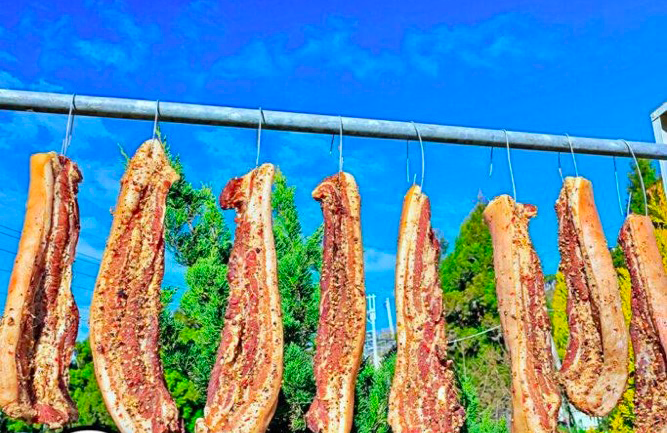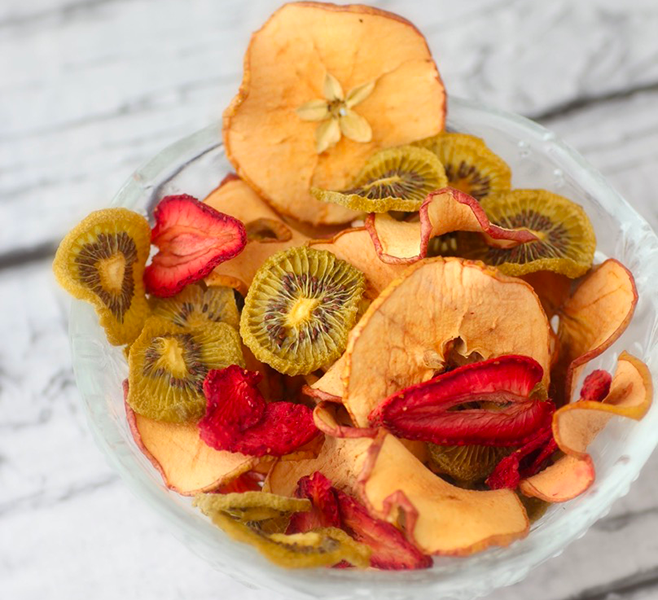
Content Menu
● Understanding Dehydration
● Why Dehydrate Food?
● Methods to Dehydrate Food without a Dehydrator
>> 1. Using Your Oven
>> 2. Sun Drying
>> 3. Toaster Oven Method
>> 4. Microwave Dehydration
>> 5. DIY Dehydrator
● Additional Techniques
>> 6. Air Drying
>> 7. Freeze Drying (Home Method)
● Tips for Successful Dehydration
● Conclusion
● FAQs
>> 1. Can I dehydrate any type of food?
>> 2. How do I know when my food is fully dehydrated?
>> 3. How should I store dehydrated foods?
>> 4. Can I use frozen fruits or vegetables?
>> 5. Is sun drying safe?
● Citations:
Dehydrating food is an excellent way to preserve it, enhance flavors, and create lightweight snacks for various occasions. While many people rely on electric dehydrators for this task, there are numerous methods to dehydrate food without such appliances. This article explores various techniques, their benefits, and tips for successful dehydration.

Understanding Dehydration
Dehydration involves removing moisture from food to inhibit the growth of bacteria, yeast, and mold. Most fruits and vegetables contain 80-95% water, while meats can have 50-75% moisture. By reducing this moisture content to below 20%, food can be preserved for extended periods without refrigeration.
The process of dehydration not only helps in preservation but also intensifies the flavors of the food. For instance, dried fruits like apricots and raisins have a much richer taste compared to their fresh counterparts.
Why Dehydrate Food?
- Preservation: Extends the shelf life of food significantly, making it ideal for long-term storage.
- Flavor Enhancement: Concentrates flavors, making dried fruits and herbs more potent and enjoyable.
- Lightweight Snacks: Perfect for camping, hiking, or travel as they are easy to carry and consume.
- Cost-effective: Reduces waste by preserving excess produce that might otherwise spoil.
- Health Benefits: Dried fruits can be a healthier alternative to processed snacks. They are often free from preservatives and added sugars when prepared at home.
Methods to Dehydrate Food without a Dehydrator
1. Using Your Oven
One of the most accessible methods for dehydrating food is using your oven. Here's how to do it:
- Preparation: Slice fruits and vegetables into uniform pieces (about ¼ inch thick) to ensure even drying. For fruits like apples or bananas, soaking them in a mixture of lemon juice and water can prevent browning and enhance flavor.
- Temperature Setting: Preheat your oven to its lowest setting, ideally between 120°F (49°C) and 140°F (60°C). If your oven doesn't go that low, set it to "warm" and keep the door slightly ajar to allow moisture to escape.
- Drying Process: Place the prepared food on cookie sheets lined with parchment paper or silicone mats. Space them apart to allow airflow. Rotate the trays every couple of hours for even drying. Depending on the type of food being dehydrated, drying can take anywhere from 6 to 10 hours.
- Monitoring: It is crucial to monitor the food regularly to prevent over-drying or burning. Use an oven thermometer if necessary to ensure accurate temperatures.
2. Sun Drying
Sun drying is a natural method that works best in hot, dry climates.
- Preparation: Slice fruits or vegetables thinly and place them on a clean screen or tray.
- Protection: Cover with cheesecloth or mesh to keep insects away while allowing air circulation.
- Location: Place the trays in direct sunlight for several days until fully dried. This method is particularly effective for tomatoes, peaches, and herbs.
- Timing: The drying time can vary significantly based on weather conditions; ideally, aim for temperatures above 85°F (29°C) with low humidity for optimal results.

3. Toaster Oven Method
If you have a toaster oven, it can also serve as a dehydrator.
- Setup: Set the toaster oven to its lowest setting and leave the door slightly open for airflow.
- Monitor Closely: Check frequently as toaster ovens can vary in temperature. This method is great for small batches of jerky or fruit slices.
- Efficiency: Toaster ovens are typically more energy-efficient than conventional ovens when dehydrating smaller quantities of food.
4. Microwave Dehydration
Microwaving is a quick method but requires careful monitoring.
- Technique: Place thin slices of fruits or herbs on a microwave-safe plate. Use the lowest power setting and microwave in short intervals (1-5 minutes), checking frequently until dried.
- Caution: Be careful not to overcook as microwaves can easily burn the edges of your food while leaving other parts moist.
5. DIY Dehydrator
For those who enjoy DIY projects, creating your own dehydrator can be rewarding.
- Materials Needed: Use a box fan, some screens or racks, and a heat source (like light bulbs) to create airflow and warmth.
- Setup: Arrange the food on racks in front of the fan with a light source nearby to provide gentle heat.
- Airflow: Ensure there's enough space between pieces for air circulation; this method can take longer than electric dehydrators but is effective for those on a budget.
Additional Techniques
6. Air Drying
Air drying is another simple method suitable for certain herbs and leafy greens.
- Method: Gather herbs into small bundles and tie them together with string. Hang them upside down in a warm, dry place with good air circulation until completely dried.
- Usage: This method works well for herbs like basil, thyme, oregano, and mint.
7. Freeze Drying (Home Method)
While traditional freeze-drying requires specialized equipment, you can mimic this process at home using your freezer:
- Preparation: Slice fruits or vegetables thinly and spread them out on a baking sheet in a single layer.
- Freezing Process: Place the baking sheet in the freezer until completely frozen (several hours).
- Vacuum Sealing (Optional): If you have vacuum sealing bags, seal the frozen items before returning them to the freezer; this helps preserve flavor and texture after rehydration.
Tips for Successful Dehydration
- Uniform Slices: Ensure all pieces are cut uniformly for even drying; thicker pieces will take longer to dry.
- Avoid Fatty Foods: Trim visible fat from meats as it can become rancid over time during storage.
- Storage Conditions: Once dried, store foods in airtight containers in a cool, dark place to maintain freshness; glass jars or vacuum-sealed bags work well.
- Labeling: Always label your containers with dates so you know when they were dehydrated; this helps track freshness.
- Rehydration Tips: When rehydrating dried foods, soak them in warm water or broth before using them in recipes; this helps restore some texture and flavor.
Conclusion
Dehydrating food without an electric dehydrator is not only feasible but also allows for creativity in preserving your favorite ingredients. Whether using an oven, sun drying, microwaving, or even creating your own DIY dehydrator, each method has its advantages depending on your resources and preferences. With proper techniques and care in preparation and storage, you can enjoy delicious dried foods year-round while minimizing waste from fresh produce.

FAQs
1. Can I dehydrate any type of food?
Yes! Most fruits, vegetables, herbs, and lean meats can be dehydrated successfully using various methods; however, some foods may require specific techniques for best results.
2. How do I know when my food is fully dehydrated?
Food should be dry but still pliable; it should not feel sticky or moist when touched. For example, dried fruits should be leathery but not hard like chips.
3. How should I store dehydrated foods?
Store in airtight containers in a cool, dark place to extend shelf life; consider using vacuum sealing methods if available for optimal preservation.
4. Can I use frozen fruits or vegetables?
Yes! Frozen produce can be dehydrated directly; however, ensure they are thawed before slicing if you want even drying results.
5. Is sun drying safe?
Yes! As long as you protect the food from insects and ensure it's dried thoroughly to prevent spoilage; it's essential that you monitor weather conditions during this process closely.
Citations:
[1] https://food-hacks.wonderhowto.com/how-to/dehydrate-food-without-dehydrator-0161531/
[2] https://www.reddit.com/r/trailmeals/comments/iq5jaf/meals_without_dehydrator/
[3] https://www.rei.com/learn/expert-advice/how-to-dehydrate-food.html
[4] https://create.vista.com/photos/dehydrator/
[5] https://www.youtube.com/watch?v=Zl4wTcCPJu0
[6] https://www.youtube.com/watch?v=IK3AQ0jYUFs
[7] https://www.cnet.com/home/kitchen-and-household/dont-have-a-dehydrator-use-your-oven/
[8] https://www.tracelessintiveden.com/l/diy-dried-food/
[9] https://learn.eartheasy.com/guides/a-beginners-guide-to-dehydrating-food/
[10] https://www.freepik.com/free-photos-vectors/food-dehydrator
[11] https://www.youtube.com/watch?v=mtDzdYoyeR8
[12] https://farmingmybackyard.com/dehydrating-foods-without-electricity/











